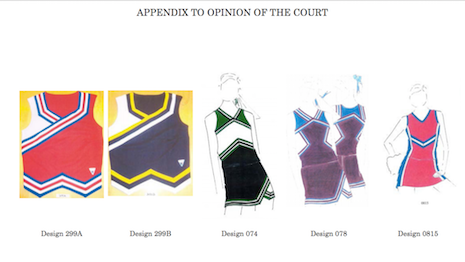- About
- Subscribe Now
- New York,
March 28, 2017

 Milton Springut is a partner at Springut Law PC
Milton Springut is a partner at Springut Law PC
The United States Supreme Court decision March 22 in Star Athletica LLC v. Varsity Brands Inc. presents an opportunity for the luxury goods/fashion industry to secure expanded copyright protection for certain creative designs.
The court ruled that geometric designs applied to cheerleader uniforms could be protected by copyright. The designs, from the decision’s appendix, are reproduced a few paragraphs below.
What the Star Athletica ruling covers
The court’s ruling clarifies and simplifies copyright protection of decorative features of useful objects.
It has long been the law that copyright protection cannot be used to cover useful objects.
The design of many fashion objects – apparel, shoes, handbags and other accessories – are excluded from copyright, because they are useful objects. Two notable, and longstanding exceptions are jewelry and fabric designs.
But the Copyright Act says it does cover “pictorial, graphic, or sculptural features that can be identified separately from, and are capable of existing independently of, the utilitarian aspects of the article.”
Just how to apply this exception has divided courts for a long time.
The Supreme Court decision adopts a simple and expansive test: a feature of a useful article is copyrightable if (1) it can be perceived as a two- or three-dimensional work of art separate from the useful article; and (2) the feature would by itself qualify for copyright – meaning the feature could have an independent existence that is not itself either a useful article or “normally a part of” a useful article.
Under this new test, many decorative features of fashion items will now be found copyrightable.
In Star Athletica, for example, the dispute was whether decorative designs on uniforms – the arrangements of colors, shapes, stripes and chevrons – were sufficiently separate from the overall design of the useful object, the uniforms, to be protectable.
Previously, many courts would have ruled not, but the Supreme Court, applying a two-step test, now has ruled they are.
 Star Athletica case designs
Star Athletica case designs
What it means for the luxury goods industry
Star Athletica’s effect is best appreciated by comparing the advantages of copyright over design patents – which do protect designs of useful objects such as apparel and accessories.
Design patents have a limited life – 14 years. The owner has no rights until granted by the Patent Office – a relatively drawn-out and expensive process. And the standard for protection is stringent: novel and non-obvious over all that was known in the field.
On the other hand, copyrights have a very long life – life of the author plus 70 years, or for works made on behalf of an employer, 95 years from first publication or 120 years from creation, whichever is shorter.
Copyright protection attaches upon creation – or, more technically, when “fixed in a tangible medium” – of the design, registration is only required to bring suit.
Although there are advantages to registering early, registration can even be done after copying is discovered. And the standard for copyright is originality, meaning the designer used some level of creativity independent of prior works, and not novelty.
The owner of a design will almost always prefer to have a copyright in its design instead of a design patent. Star Athletica now expands the range of copyrightable fashion designs.
Star Athletica is not, of course, a wholesale revamp of U.S. design protection law.
As the case makes clear, many fashion designs – the overall design of a dress, handbag or shoe – still remain outside copyright, and the designer must turn to design patent law for protection.
And, of course, as the court itself noted, there are other requirements for copyright protection that have to be met – the design has to be sufficiently original, showing at least minimal creativity, to qualify.
But there are numerous design features used by the luxury goods industry that now likely qualify for copyright protection under this new decision.
WHILE THE FULL effect of any Supreme Court decision may not be appreciated until it percolates through real disputes brought in lower courts, for now you should think about the following:
(1) If designers foresee a particular design becoming very popular and thus likely to be copied and knocked off, and it has some feature or features that could be viewed as separate from the item, then early registration of copyright should be pursued.
(2) We are likely to see increased assertions of copyright claims by luxury goods/fashion companies, both against pirates as well as legitimate competitors. If you have been knocked off, consider what copyrights you may have. Remember that you can still register after discovering infringement – although you may be giving up some remedies, you can still bring suit to stop the copying.
(3) Designers considering “borrowing” or being “inspired” by design features from other designers now need to be extra careful and confer early on with their IP counsel that they do not tread on such rights.
Please click here to access documentation in the Star Athletica LLC v. Varsity Brands Inc. case
PDF of the Star Athletica LLC v. Varsity Brands Inc. ruling
Milton Springut is a partner at Springut Law PC, New York. Reach him at ms@springutlaw.com.
Share your thoughts. Click here